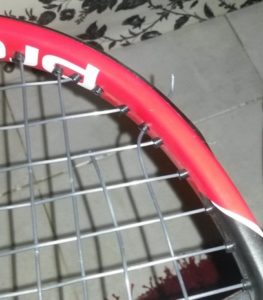 Imagine a brand new tennis racquet equipped with perfectly installed and completely flawless new string. Nobody has ever used this racquet before. Now imagine a recreational tennis player (or a total pro — it doesn’t really matter which) tossing a regular ball into the air and hitting it for the very first time with this brand new racquet.
Imagine a brand new tennis racquet equipped with perfectly installed and completely flawless new string. Nobody has ever used this racquet before. Now imagine a recreational tennis player (or a total pro — it doesn’t really matter which) tossing a regular ball into the air and hitting it for the very first time with this brand new racquet.
Now imagine that the string breaks — because it CAN happen. Even under perfect conditions with a perfect racquet with perfect strings that are perfectly installed, it is entirely possible for the strings to break the very first time they ever strike a ball.
How can this happen? Typically, it is the result of what we call a “shear break”. Shear breaks occur most often on serves or overhead smashes when a ball is hit with a high degree of force off center near the frame. It doesn’t have to be a smash or a serve though, shear breaks can happen on ground strokes, too. Anytime you hit a ball off centre out near the frame of the racquet a shear break can occur.
When a ball is hit with the centre of the string bed, the load is shared evenly by a bunch of strings. Together they are strong. But when a ball is hit off center, the load is carried by fewer strings. And if this load it too much, one or more strings may break under the strain — even if they are new strings in a new frame installed by the world’s best stringer.
The image top right in this article shows a typical shear break on polyester string. It has broken along the grommet line, probably as a result of an off center serve or smash. Whether the strings are new or old (used or unused) in these events actually matters very little. The break is caused by the overwhelming force of contact with the ball, a force that is too large for the material to withstand.
So what can players do to minimize these kinds of string breaks? For many, it’s as simple as taking some lessons and learning how to serve using the center of the string bed. For others, it’s a matter of taking some pace off of their serve and learning to place it rather than pound it.
In general, switching to a stiff polyester string just because you are consistently breaking strings on your serve is not a good idea. Doing this may result in a racquet that is durable enough to withstand your serve but too stiff for rallying or volleying. In other words, it may help you on your serve, but it may kill you on your ground strokes.
A much better idea is to listen to what your strings are telling you. They may be saying “Ouch!”. “Too hard.” “Time for a serve lesson.” Persistent shear breaks are more often a sign of bad technique than a sign of poor quality strings. So if the strings you are breaking are good quality strings to begin with, then you may want to listen to what they have to say.
TEST PREPARATION
The following questions may appear on tests related to this article. Use them to test your reading comprehension and prepare for the CERTIFIED EXPERTS TEST – RACQUET SERVICE.